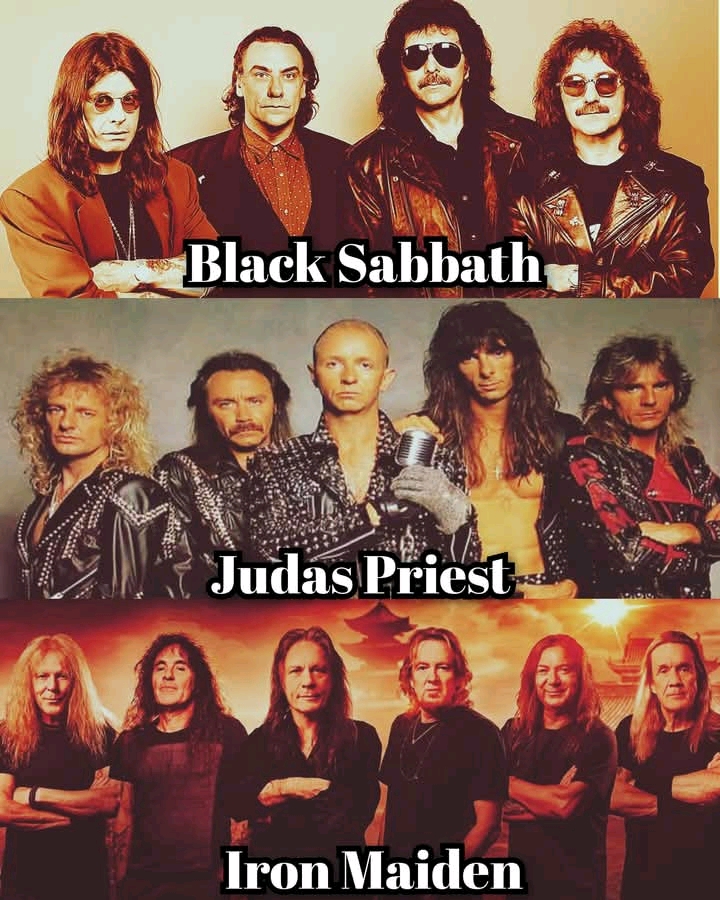THE TRUE DEFINITION OF HEAVY METAL: How Judas Priest, Black Sabbath, and Iron Maiden Forged the Genre with Relentless Effort and Timeless Legacy
In the chaotic heart of 1970s England, amidst the soot-stained factories and economic uncertainty, a genre was born—one that would transcend borders, cultures, and generations. That genre was heavy metal, and its most defining architects were Black Sabbath, Judas Priest, and Iron Maiden. These three British bands didn’t just play music—they carved out a new sonic and cultural identity through tireless dedication, revolutionary sound, and an unbreakable connection with fans. They are the true definition of heavy metal.
Black Sabbath: The Birth of Darkness
It all began in Birmingham, an industrial city where factory noise and working-class struggle inspired four young men to create something ominous, raw, and powerful. Black Sabbath, led by the iconic Ozzy Osbourne, along with Tony Iommi, Geezer Butler, and Bill Ward, changed music history with the release of their self-titled debut in 1970.
But behind the scenes, the journey was anything but glamorous. Tony Iommi, the band’s guitarist and sonic architect, had lost the tips of his fingers in a factory accident. Instead of giving up, he adapted, creating a new guitar technique and down-tuned sound that would define metal’s dark and heavy tone.
Their lyrics weren’t about peace and love—they tackled war, addiction, and social decay. It wasn’t just rebellion; it was a mirror to reality. Albums like Paranoid, Master of Reality, and Vol. 4 became the blueprint of the genre. Sabbath didn’t just start heavy metal—they gave it depth and soul.
Judas Priest: Refining the Steel
While Sabbath lit the torch, Judas Priest sharpened the blade. Emerging in the mid-’70s with albums like Sad Wings of Destiny and Sin After Sin, they introduced a new level of intensity and precision. With Rob Halford’s piercing vocals and Glenn Tipton and K.K. Downing’s twin guitar attacks, Priest took heavy metal from the underground and gave it speed, power, and style.
Priest worked relentlessly in the studio and on the road. In their early days, they were so broke they could barely afford food. Yet they pressed on, driven by passion. Their transformation in the late ’70s with albums like Hell Bent for Leather and British Steel solidified them as global metal titans. They dressed the part too—Halford’s leather-and-studs look not only became his signature, it became heavy metal fashion.
Perhaps Priest’s greatest achievement is their commitment to evolution. From the raw edge of Stained Class to the turbo-charged Painkiller, they never settled. Their influence is immeasurable—power metal, thrash, speed metal, all owe a debt to Priest’s tireless innovation.
Iron Maiden: The Guardians of Epic Metal
By the dawn of the 1980s, heavy metal was evolving again—and Iron Maiden emerged as the leaders of the New Wave of British Heavy Metal (NWOBHM). Founded by bassist and songwriter Steve Harris, Maiden brought a theatrical, galloping intensity unlike anything before.
With Bruce Dickinson’s operatic vocals, Adrian Smith and Dave Murray’s melodic guitar harmonies, and lyrics steeped in history, mythology, and literature, Iron Maiden elevated metal into high art. Their albums—The Number of the Beast, Powerslave, Seventh Son of a Seventh Son—were not just records, they were experiences.
Maiden’s commitment to excellence is legendary. They tour harder than almost any band on Earth, playing massive arenas and flying their own plane (piloted by Dickinson himself). They don’t rely on trends or radio play—they’ve built their empire purely through connection with their fans.
The Heavy Metal Legacy
What makes these three bands the true definition of heavy metal isn’t just their music—it’s their work ethic, vision, and refusal to compromise. They’ve endured lineup changes, personal hardships, and shifting industry tides, yet remained pillars of the genre.
Each brought something essential:
- Black Sabbath gave it roots and darkness.
- Judas Priest gave it power, precision, and style.
- Iron Maiden gave it epic scope, imagination, and fierce independence.
In a world of fleeting pop trends, heavy metal has stood firm—and these three titans are the reason why. Their influence continues to shape new generations of musicians and fans alike. As long as metal lives, so will the legacies of Black Sabbath, Judas Priest, and Iron Maiden—the holy trinity of heavy metal.
